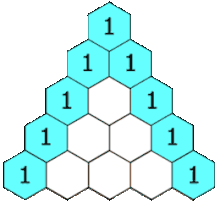
Pascal's Triangle is a mathematical object that looks like a triangle with numbers arranged the way like bricks in the wall. Each next row has one more number, ones on both sides and every inner number is the sum of two numbers above it. It can span infinitely.

Despite simple algorithm this triangle has some interesting properties. First, if you draw only odd numbers, you get a fractal - Sierpinski Triangle.

Second, graph of numbers in each row resemble Gaussian distribution function. The lower row you take from the triangle (containing more numbers), the more precise graph you get.

I've made these images with Octave - a free Matlab alternative. I like it and I think concepts behind this Matlab programming language can be quite useful for doing computations, but doing graphics is painfully slow.
From Adam Sawicki's weblog, here
Number theory is the branch of pure mathematics concerned with the properties of numbers in general, and integers in particular, as well as the wider classes of problems that arise from their study.
Number theory may be subdivided into several fields, according to the methods used and the type of questions investigated. (See the list of number theory topics.)
The terms "arithmetic" or "the higher arithmetic" as nouns are also used to refer to elementary number theory. These are somewhat older terms, which are no longer as popular as they once were. However the word "arithmetic" is popularly used as an adjective rather than the more cumbersome phrase "number-theoretic", and also "arithmetic of" rather than "number theory of", e.g. arithmetic geometry, arithmetic functions, arithmetic of elliptic curves.
In probability theory, the normal (or Gaussian) distribution, is a continuous probability distribution that is often used as a first approximation to describe real-valued random variables that tend to cluster around a single mean value. The graph of the associatedprobability density function is “bell”-shaped, and is known as the Gaussian function or bell curve:[nb 1]
where parameter μ is the mean (location of the peak) and σ 2 is the variance (the measure of the width of the distribution). The distribution with μ = 0 and σ 2 = 1 is called the standard normal.
The normal distribution is considered the most prominent probability distribution in statistics. There are several reasons for this:[1]First, the normal distribution is very tractable analytically, that is, a large number of results involving this distribution can be derived in explicit form. Second, the normal distribution arises as the outcome of the central limit theorem, which states that under mild conditions the sum of a large number of random variables is distributed approximately normally. Finally, the “bell” shape of the normal distribution make it a convenient choice for modelling a large variety of random variables encountered in practice.
 |
| This Sierpinski pyramid was the first I made for my boys in the 1980s. It has a fractal dimension of exactly D=2 because to make a pyramid twice the (linear) size, you need four times as many blocks, and 4=2D, that is D=log4/log2. (See the Sierpinski triangles on each face.) ... Professor Tony Roberts |
 |
| Minneapolis-St. Paul Bridge Maintenance Department |
 |
| Biological Sierpinski |
 |
| Frat House Sierpinski |
 |
| Sierpinski drawn by a 12-year old Girl |
 |
| Sierpinski drawn by a 12-year old Boy |




3 comments:
Hi Steven,
Yes Pascal has been of quite interest to me as well.
The Galton Box is a interesting correlation in thinking as to outcome? Some might use mountains and pebbles...others still out comes as numbered systems as to the way in which the world expresses itself.
I tried abstractly to show that from symmetry(where is this?) has an asymmetrical relation as to the bean, as if, the energy enters into expression at the peak and arrives somewhere at it's based? Yes pyramidal:)
Best,
Cool, thanks, Plato. In the article:
A large-scale working model of this device can be seen at the Museum of Science, Boston in the Mathematica exhibit.
I've been there. It's an OK museum. My favorite is still the Hall of Science Queens, NY. They have that too, as well as the best Mathematics section of any Science Museaum I have ever seen.
I haven't been to San Fran's Exploratorium though, Jennifer Ouelette thinks that's the best ... Science museum.
America has only one Math museum (a crime), on the north shore of Long island and I think that's down for repairs. What does Canada have?
cheeeeeeeeeeeeeeeeeeeeeeeeeeeeeeeeeeeeeeeeeeeeeeeeeeeeeeeeeeeeesey feet
Post a Comment